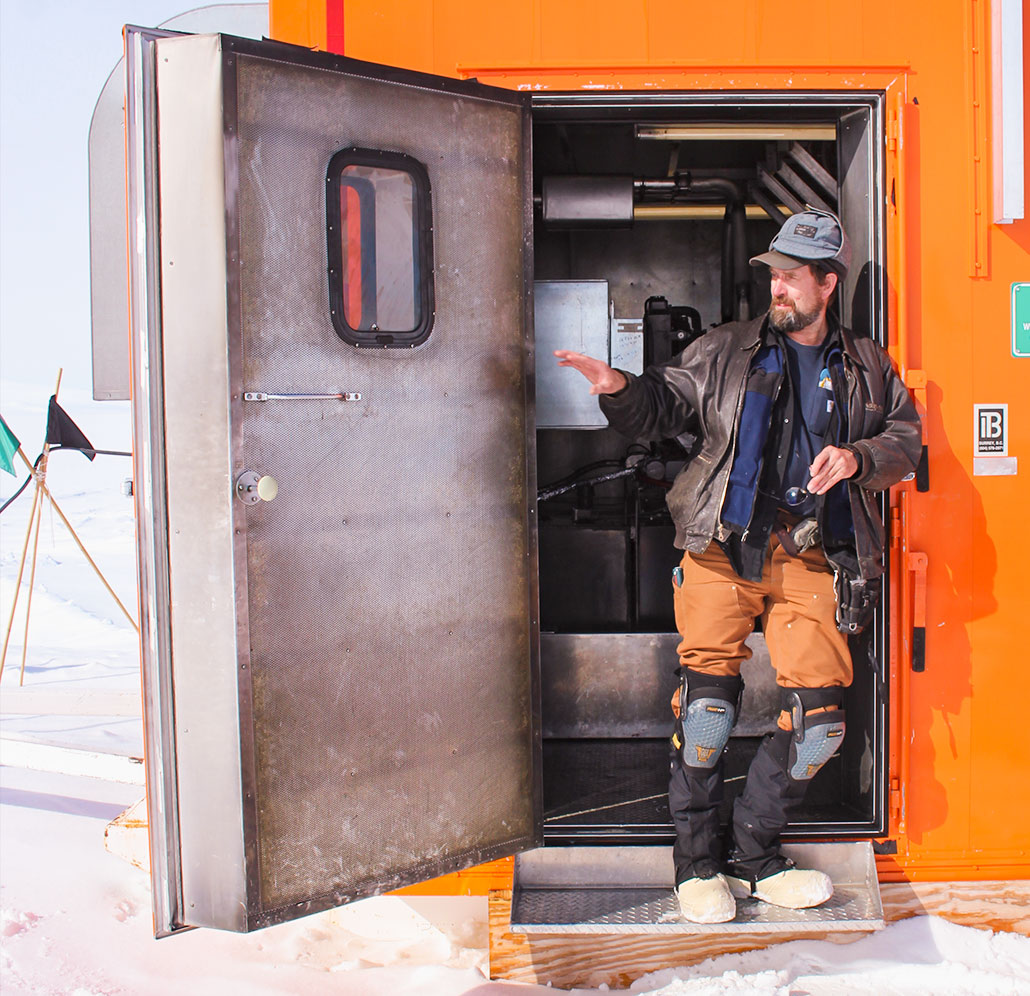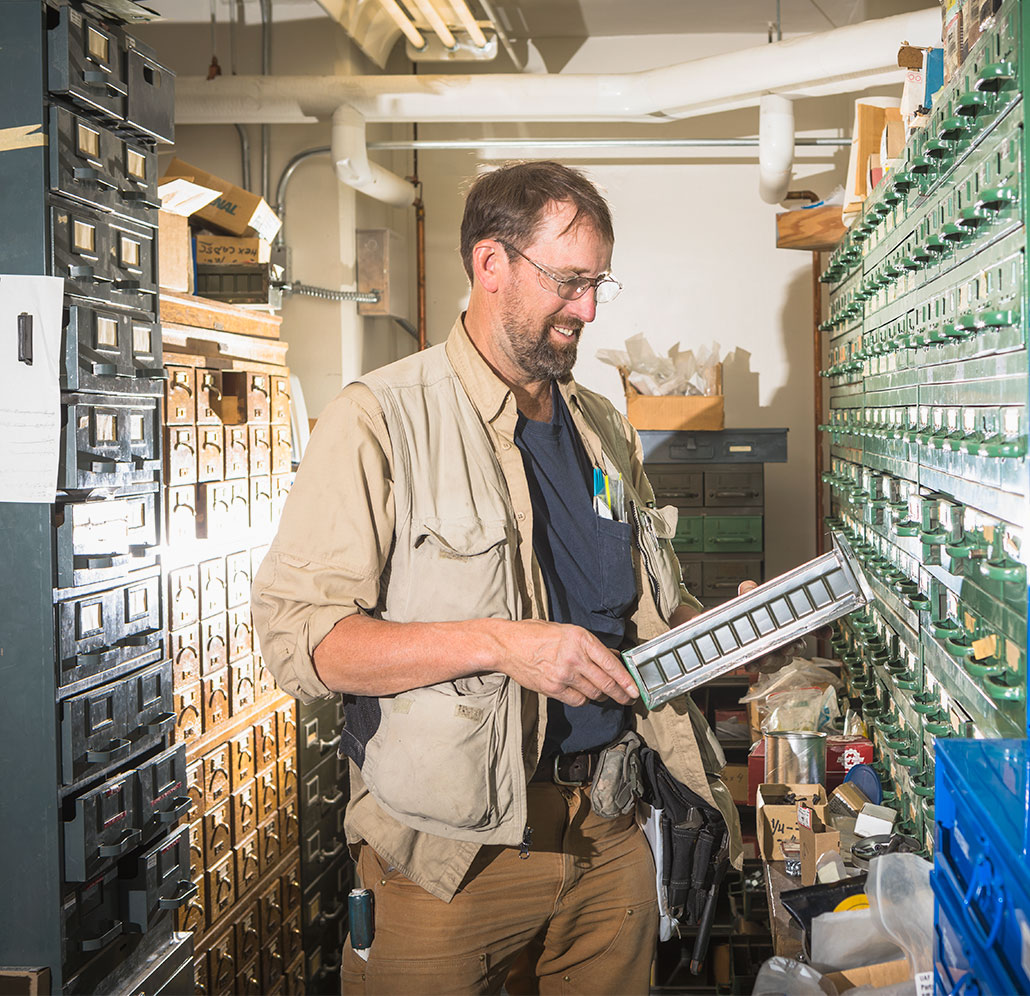Dale Pomraning: Academic tool (in the best possible way)
June 29, 2018
Dale Pomraning carries enough tools to repair most anything.
Upon request, he starts pulling them from pockets in his khaki shirt, game vest and sturdy canvas pants, as well as from a small black pouch attached to his belt. He places on the table a utility knife, wire cutters, tiny folding tweezers, a six-way screwdriver set, two tape measures, a 5-inch vice grip, a red flashlight, a spare flashlight, several bunches of keys, a small pocket knife, a medium-size pocket knife, and two Gerber multitools.
By the time his pockets are empty, he’s pulled out 53 items, including adjustable wrenches, an optical loupe, a small rainproof notebook, carbide scribes for writing on metal and a small mirror on a long handle for looking underneath things.
Pomraning’s fascination with tools started early.
As a toddler, he didn’t sleep with stuffed toys. “I would take wrenches to bed with me, and light bulbs and electrical fittings,” he said. “It was always mechanical things.”
Small wonder that Pomraning, 54, grew up to be a machinist and a mechanic with such outstanding skills that scientists write him into research grants and acknowledge his contributions in scientific journals.
As lead machinist in UAF’s Geophysical Institute Machine Shop, Pomraning is an internationally sought-after expert on a number of techniques. His specialties include using high-pressure hot water to drill holes in glaciers or ice sheets. He has been part of 12 scientific expeditions to Antarctica.
“There are probably hundreds of stories of Dale coming through in a pinch,” said Martin Truffer ’99, UAF physics professor and a member of the GI’s Snow, Ice and Permafrost research group.
id="1"
Once, when Truffer’s research team was working on Taku Glacier near Juneau, a student planned to collect sediments from under the glacier through a hole already drilled for the main mission. The student built equipment in Fairbanks to collect the samples, but it didn’t work at the site.
“Dale worked on the problem for half a day, and then we had sediment samples,” Truffer said. By cutting various pieces out of scrap material that the team happened to have on the glacier, Pomraning put together a device that worked.
“He’s just a really exceptional mechanic,” Truffer said.
Always a mechanic
Pomraning grew up on a farm near Anoka, Minnesota, just north of Minneapolis.
“We fixed everything on the farm ourselves,” Pomraning said. “You can’t afford to take it to pay someone to get it fixed, nor the lost time.”
When he was about 10 years old, he accompanied his dad on a visit to a machine shop in town. He did so well in advanced high school shop classes that he could skip a quarter of the requirements for a two-year tech machinist program. Ten years later, he was working at that same machine shop in Anoka.

After a few years, he got itchy.
“I was a young guy, and I enjoyed my job there, but I was a little bit adventuresome,” Pomraning said.
In 1989, he was hired as the winter-over machinist at McMurdo Station on Ross Island, Antarctica. Workers who spend the winter in Antarctica are there for the duration because they can’t leave. All aircraft traffic to and from Antarctica is discontinued from February through August, the winter season, because of severe storms and extreme conditions. The sun goes down in May and comes up in September, and in the depths of winter temperatures can be colder than 100 degrees below zero Fahrenheit. Crew members must be prepared to deal with anything that comes up, using their wits and whatever they have on hand.
The next year, Pomraning drove up the Alaska Highway in February to help a buddy in Fairbanks. A UAF group working on a National Science Foundation contract to support research in Antarctica heard about Pomraning. They wanted to know more about a mechanic and machinist who would winter over at McMurdo and then do it again in Fairbanks. They hired him for a crew they were assembling to go to the South Pole.
His task was to design and build equipment to drill 2-foot-wide holes 1.25 miles down into the ice at the Amundsen-Scott South Pole Station. These holes were bigger and deeper than had ever been drilled in ice before. The scientists wanted to create a specialized telescope by lowering sensors into the ice that could detect neutrinos — tiny, high-energy particles hurtling through space — that had passed through the Earth from the Northern Hemisphere and were exiting through the Antarctic ice.
“I think they were impressed that I knew what a neutrino was,” Pomraning said.
That expedition was just the first of many interesting UAF and GI science projects that have called on Pomraning’s expertise.
Truffer, the physics professor, has worked with Pomraning for 20 years. They first met on Black Rapids Glacier off the Richardson Highway south of Fairbanks, working on Truffer’s Ph.D. thesis research.
“We drilled all the way through the glacier there,” to study how ice moves under the glacier, Truffer said. “It’s really hard to get these measurements because it’s so hard to look.” Pomraning designed and operated the equipment necessary for the scientists to get their data.
Truffer and Pomraning’s work on a multiyear study of West Antarctica’s Pine Island Glacier was reported last year in a major paper published in the journal Nature. Truffer was a co-author; the other scientists were from Britain, Denmark, Germany and Switzerland as well as the Lawrence Livermore National Laboratory and NASA. In the paper’s acknowledgements, the first thank-you was to Dale Pomraning for his help with designing and manning the hot-water drill equipment.
Working at the shop
“I have met people in this profession almost like Dale, but never just like Dale,” said Greg Shipman, manager of the GI’s Machine Shop since 2002. “I won’t tell him this, because he’ll get a swelled head, but I would hate it if Dale wasn’t here.”
Having the capabilities of professional machinists available to fabricate specialized equipment for scientific studies has been a high priority at the Geophysical Institute from the very beginning. A report from first GI Director Stuart Seaton in 1949 said that as of July 1, 1950, “there will be available … an instrument shop with machine tools” in the GI’s first home, the Chapman Building.
Shipman explained that the Machine Shop is a service center for scientists, researchers and grad students at the GI. Their main function is to fabricate devices, machines or equipment that researchers cannot buy off the shelf. The three people who work in the Machine Shop must be not only machinists, but also welders, carpenters, repairmen, mechanical designers and draftsmen.
“Someone comes in here with a concept or an idea, and we have to turn it into reality,” Shipman said. “I never know what’s walking through that door.”

They can build devices accurate to 1/1000 of an inch.
“We have worked on things that the accuracy level is so high that if you change the temperature in the room, you change the dimensions,” Shipman said.
After years of working as a team member on contract with UAF for various projects, Pomraning was hired full-time to work in the GI Machine Shop in 1998 by Larry Kozycki, legendary shop manager from 1982 until his death in 2001.
“He was a serious man,” Pomraning said of Kozycki. “It had to be perfect. When Larry spoke, people stopped.”
Before being hired full-time at the GI, Pomraning brought in projects from the UAF contract jobs he worked on. He had designed a big winch, one of four, and he brought the blueprints over for Kozycki.
“He flipped that blueprint back at me and said, ‘Dale, you’re missing a couple dimensions on this blueprint. Is that the best you high-paid engineers can do?’” Pomraning recalled. “And I said ‘Larry, I’m not an engineer, I’m just a machinist.’ That made a difference, because he knew that he had to get up pretty early to keep up with me, and I felt the same way about him.”
In winter 2017-2018, Pomraning traveled to Antarctica with Jay Helmericks ’98, ’01, of the GI’s infrasound unit, to maintain sensors that monitor for nuclear explosions. Researchers at the GI in the 1960s pioneered the study of infrasound — low-frequency acoustic waves of less than 20 hertz (cycles per second) — generated by the aurora. The Comprehensive Nuclear Test Ban Treaty Organization also uses infrasound to detect nuclear detonations. Today, the Wilson Alaska Technical Center at the GI manages a number of the treaty organization’s infrasound arrays around the world, including one at Windless Bight near McMurdo Station. The infrasound unit at the GI also supports basic and applied research on acoustic signal processing, volcanic eruptions and auroral infrasound.
This year, maintenance of the Windless Bight infrasound facility transferred from an outside contractor to the GI, with Pomraning as lead mechanic.
“Dale’s our ace in the hole,” Helmericks said. Pomraning is familiar with the specific diesel engines used to power the infrasound facility, which has to run on its own through the Antarctic winter.
“Dale is great at coming up with creative solutions to get the job done,” Helmericks said. Sometimes that entails scrounging through trash bins at McMurdo to find bits that can be cobbled together to solve the problem.
“I know how all the diesel engine parts fit together,” Pomraning said. “If there’s a problem, then I’m there to fix it.” He noted that the South Pole and McMurdo stations have excellent machine shops that he can use to build any parts or tools needed.
I think they were impressed that I knew what a neutrino was.
“When I’m in the field, I already have a vision of what’s inside the machine before I take it apart,” Pomraning said. That knowledge gives him the ability to disassemble it without damage and reassemble it to be functional. That’s his superpower.
“When my father was fixing a tractor or some machinery, I was out there watching him do it, and then I would take his tools and I would wander around carrying them. So if he was missing some tools he’d go find me.”
“People ask me ‘How long have you been a mechanic, Dale?’ And I answer, ‘All my life!’” ![]()

What’s in your pockets?
Few of us load our pockets with the vast array of items that machinist Dale Pomraning does (see tool spread above). But surely some of you carry some interesting items.
We want to know! Send an email to aurora.magazine@alaska.edu detailing “what’s in your pockets,” along with a photo of yourself (with or without the items from your pockets). For fun, we’ll print a selection in our next issue.


